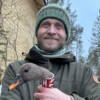Framland breeding birds
Summary
The populations of farmland breeding birds have declined considerably. The decreasing trend of farmland birds has continued up to the present. Birds nesting in fields, verges, and around agricultural buildings have widely suffered from the intensification of agriculture, particularly due to the reduction in open ditches, verges, and cattle grazing, as well as the use of chemical pesticides.
Status
The status of the indicator is bad. With ninety percent certainty, the populations of farmland birds are at least 32 percent smaller than at the beginning of the monitoring period at the turn of the 1970s and 1980s. It is possible that the decline is even stronger.
Of the 13 species in the indicator, the populations of two species, the jackdaw and the Eurasian tree sparrow, have multiplied several times compared to the early 1980s both due to their strong spread and increasing nubers of individuals. The populations of the northern lapwing and the fieldfare have also increased. The corncrake’s numbers have been stable in the 21st century, but the monitoring data for it only begins from 2006. The populations of all other species are smaller than at the start of the monitoring. The population of the ortolan bunting is even over 99 percent smaller. The population of the starling has recovered in the 21st century.
Trend
The development of the indicator in the 21st century is deteriorating. Since the 2000s, the populations of farmland birds have, with ninety percent certainty, declined by about one percent per year. The average decline of the populations has been steady throughout the monitoring period (1980–2024).
Significance
The indicator reflects the state of biodiversity in agricultural environments. Locally, this is manifested as the diversity and abundance of the bird populations in these environments. The habitat requirements of farmland birds are well understood, and thus changes in the indicator can be reliably linked to changes in the agricultural environment.
Of the indicator’s species, the corncrake, northern lapwing, Eurasian curlew, skylark, meadow pipit, whinchat, and ortolan bunting show the strongest ties to changes occurring in fields, as they both nest and forage in these areas. Factors such as the timing of agricultural activities, the crops grown, and the pesticides used in cultivation directly affect them.
Edge species of fields, primarily those nesting in hedge rows and trees, verges, and agricultural buildings, are shielded from the immediate effects of fieldwork. However, the impacts of fieldwork also indirectly influence their breeding success, as these species generally feed in fields. The breeding success of these species largely depends on the diversity and abundance of plant and insect species in farmlands.
Variations in the populations of farmland birds are not explained solely by changes in the habitat during the breeding season; conditions along migration routes and wintering areas, as well as climate change, also have effects. Among the indicator’s species, the fieldfare and jackdaw are not protected.
Bird monitoring forms one of the most central and reliable sources of data for biodiversity in Finland (see “Data used” below).
References
Data used
“The indicator is based on monitoring counts coordinated by the Natural History Museum, conducted partially by volunteers with professional-level bird knowledge and partially by paid researchers.
The main counting method are line transects, which since 2006 have been performed across Finland on a standardized network of lines spaced 25 kilometers apart. These six-kilometer routes total 566, and about half of them are counted annually. Before 2006, counting lines were chosen by the counters themselves. The establishment of standardized lines improved the coverage and reliability of the data. In addition to line transects, monitoring information is also gathered from point counts and mapping counts.
For farmland birds, the time series begins in 1979, when sufficient monitoring data began to accumulate for 12 species of the indicator. Two species, the corncrake and the tree sparrow, were added to the indicator in 2006. Recently, it has been proposed to remove the fieldfare from the indicator because it poorly represents the agricultural environment.
Species included in the indicator:
Corncrake – Crex crex
Northern lapwing – Vanellus vanellus
Eurasian curlew – Numenius arquata
Skylark – Alauda arvensis
Barn swallow – Hirundo rustica
House martin – Delichon urbicum
Meadow pipit – Anthus pratensis
Whinchat – Saxicola rubetra
Common whitethroat – Sylvia communis
Jackdaw – Coloeus monedula
Starling – Sturnus vulgaris
Tree Sparrow – Passer montanus
Ortolan Bunting – Emberiza hortulana
Indicator calculation
The farmland bird breeding indicator is produced by the Finnish Biodiversity Information Facility at the Natural History Museum of Finland, combining estimates of individual species’ population trends into a single index number. This multi-species indicator updates automatically and its index number reflects the ratio to the base year, which for the forest bird indicator is the year 2000.
The calculation of the multi-species indicator begins with the assessment of individual species’ population trends. These trends are estimated from the numbers of bird pairs observed during census counts using generalized linear statistical models, which also take into account differences between counting sites and dependencies between successive years.
Species-specific estimates based on sampling-dependent statistical models always include uncertainty. This uncertainty is accounted for and incorporated into the multi-species indicator through Monte Carlo simulations.
For this webservice, comparisons have been calculated from the indicator produced by the Finnish Biodiversity Information Facility, between the beginning and the end of the time series, as well as annual population trend estimates for different time periods.
Indicator as a table:
Updates and changes to the indicator
08.10.2024: Indicator was updated in October 2024. In the update, the results for the year 2024 were added. Although some slight numerical changes were made, the increase in data did not result in qualitative changes to indicator status or trend interpretation.
26.8.2024: Indicator was updated in August 2024. In the update, fieldfare was removed from the species included in the indicator. The removal of fieldfare and addition of results for the year 2023 did not result in major changes to the interpretation of the indicator status or trend.
Ask for further information

Aleksi Lehikoinen
Senior Curator (Luomus), Head of the working Group on Birds
